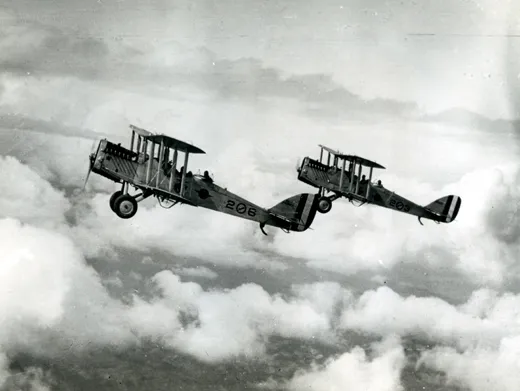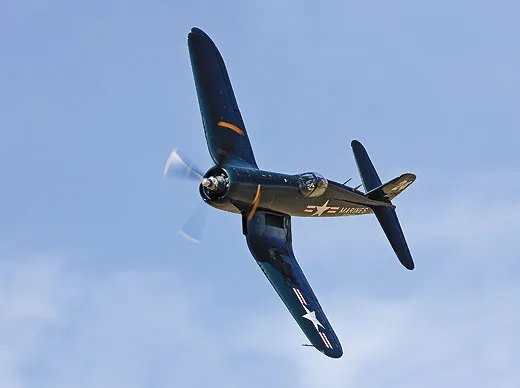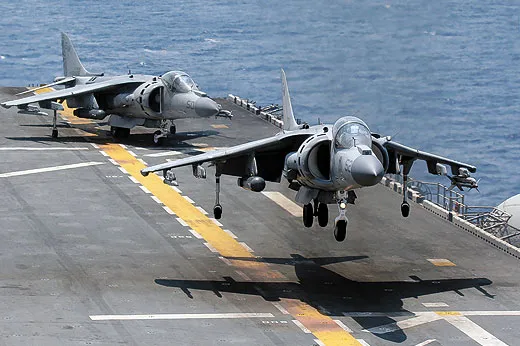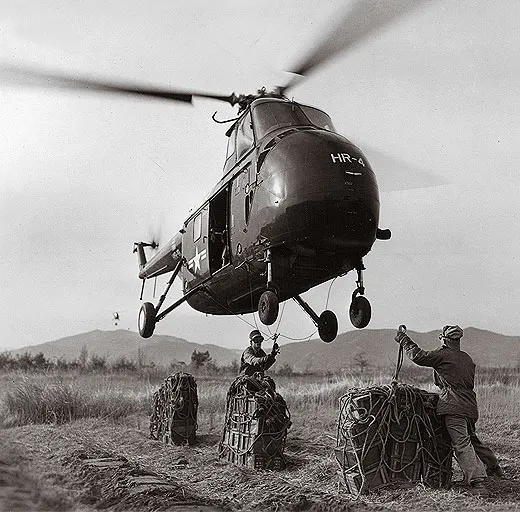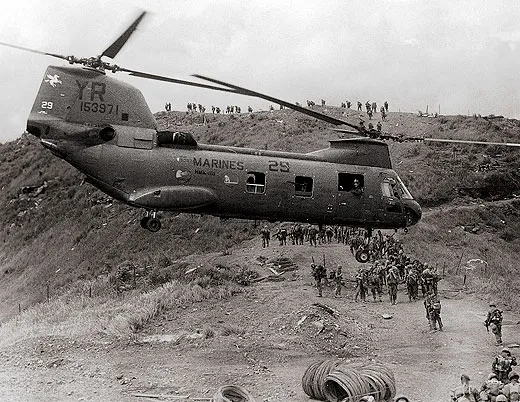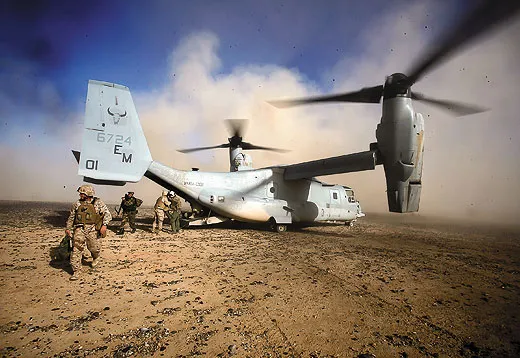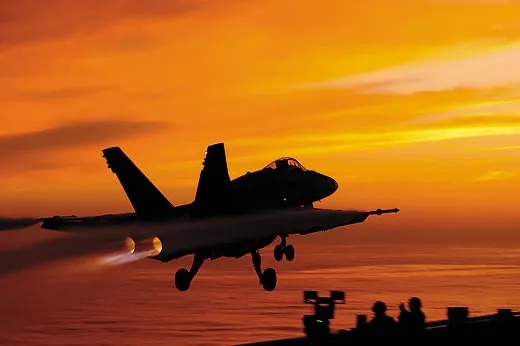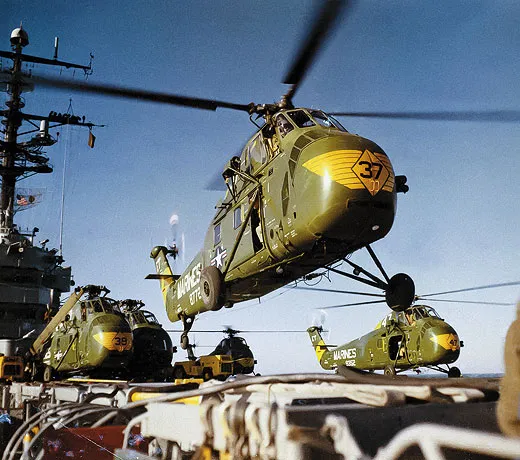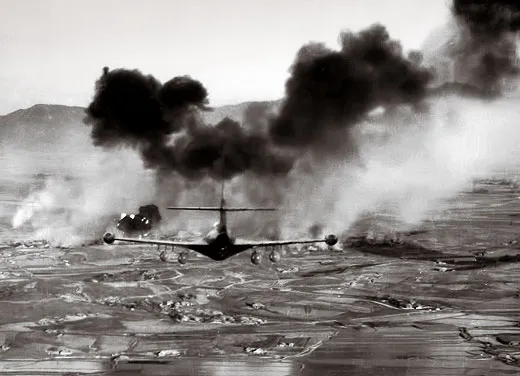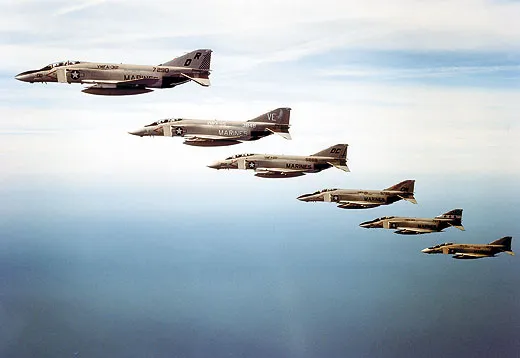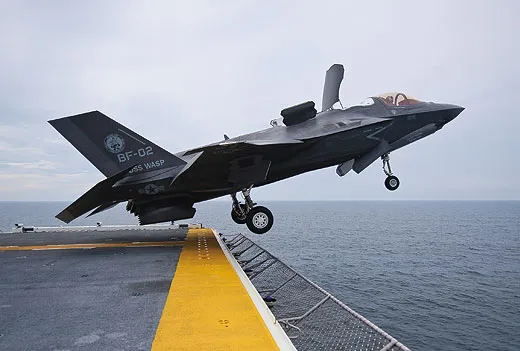100 Years of Marine Aviation
A salute to 10 aircraft that carried the few and the proud into history
/https://tf-cmsv2-smithsonianmag-media.s3.amazonaws.com/filer/100_years_of_marine_aviation_7_FLASH.jpg)
When Marine Lieutenant Alfred A. Cunningham reported to the U.S. Naval Academy for flight training on May 22, 1912, the date celebrated as the birth of Marine aviation, he didn’t start out with the idea that airplanes could be useful to ground troops. But after flying missions with British and French units during World War I and organizing the first Marine aviation group, that’s the conclusion he came to. After the war, in the September 1920 Marine Corps Gazette, he wrote that “the only excuse for aviation in any service is its usefulness in assisting the troops on the ground to successfully carry out their operations.” Marine aviators ever since have been trained with that single purpose in mind.
Alone among the flying services, the Marine Corps requires pilots to begin their training with six months of infantry school. After that, says Fred Allison, a Marine Corps historian and former F-4 Phantom radar intercept officer, “it’s a matter of learning what an airplane can do to help ground troops accomplish their missions.” The support of ground forces is more than a doctrine for Marines, says Allison; it’s part of their culture. “What’s happening on the ground is being done by the same service,” he says. In other words, sometimes those are fellow Marines down there. Moreover, he continues, in the Marines, forward air controllers—the ones who direct aircraft to targets—are always pilots. “They’re on the ground,” he says, “but they’re talking to their buddies flying above. You know how it is between friends who know each other: Immediately you’re on the same page of music.” One pilot told him, “It’s like putting on your favorite old sweatshirt. It just feels good when you’re talking to a Marine FAC on the ground as opposed to an Air Force FAC.”
The 10 aircraft we’ve selected to highlight in this anthology on Marine Corps aviation have rarely strayed far from the doctrine that Alfred Cunningham developed: The mission of a Marine in the air is to help the Marine on the ground.
—The editors
F4U Corsair: Blue Meanie
Between 1941 and 1952, the Chance Vought Corporation hammered out 12,500 handsome fighters with powerful Pratt & Whitney R-2800 radials driving Hamilton Standard propellers with a span so great—more than 13 feet—the fighter’s wing had to be bent into an inverted gull to afford the props ground clearance. (The landing gear descended from the low point of the wing.) At the time, the engine-propeller combination was the largest ever flown on a fighter, and it gave the Corsair a speed of 400 mph, which delighted Vought’s customer, the Navy. Poor pilot visibility, however, made the aircraft almost impossible to land on a carrier. And that’s how the Corsair came to join the Marines. Initially land-based, it went on to become the most ferocious and famous Marine fighter of World War II.
Most people were introduced to the lovely deep blue of the Corsair by a 1970s television series, “Baa Baa Black Sheep,” which loosely dramatized the exploits of the best-known Corsair ace: Between September 1943 and January 1944, Gregory “Pappy” Boyington shot down 26 Japanese aircraft. But students of aviation history know that the Corsair was also a danger to Japanese ground troops; it won the nickname “Angel of Okinawa” for the role it played in supporting ground forces in the battle for that island, a mission it continued to fly in the Korean War.
In one of the most famous actions in Korea, the breakout from the Chosin Reservoir, Marine air groups flew 154 sorties in one day, November 30, 1950, to help their brothers on the ground escape Chinese soldiers, who heavily outnumbered the Americans. Aided by the air strikes, the Marines began fighting their way to the coast. Marine rifleman John Cole, recorded on a CD accompanying the book 100 Years of Marine Corps Aviation, recalls what it was like to have Corsairs on his side during the desperate march to safety:
“The Corsairs would come in and help drive the Chinese off when they had roadblocks set up [to impede the retreat]. They’d gone up the valley just about dusk and were gone for a while and when it got a little closer to dark, here came three of them back down the valley, and the Chinese knew, ‘Okay it’s getting dark and they have to get back home and so that’s the end of their air support.’ And all along this ridge, you could see the fires light up because they were in the trees where they could get wood to burn. And they just got their fires going good, and everybody was getting around them to do whatever, with their rice and what have you, and here came that fourth Corsair down the valley. And you could hear his guns just a hammering. And he went right down that ridge, and boy, you talk about the lights going out. Of course all of the guys that were walking—and most of the wounded, all the guys that could walk, walked; you needed space for all the dead and those that couldn’t walk on the trucks; we were several miles long with that convoy getting out of there—and you could hear the guys yelling and screaming, ‘Hey! Way to go, flyboys!’ ”
Sikorsky HRS-1: The First Combat Troop Transport Helicopter
Of the three world-changing inventions that emerged from World War II, only two were credited with inaugurating new eras: the jet engine and the atomic bomb. But it can be argued that the third, the helicopter, had as big an impact on how wars would be fought as the other two. For the Army and Marine Corps, the period between the Korean War and today could be thought of as the Helicopter Age, and the machine that ushered it in was the Sikorsky HRS-1.
On September 2, 1951, Marine Helicopter Transport Squadron (HMR) 161 arrived in Korea with 15 HRS-1 helicopters. The first practical utility helicopter, the HRS-1 was built to carry eight troops or 1,500 pounds of equipment and cruised at 100 mph. “That, of course is under perfect sea-level conditions,” says Roger Connor, curator of rotary wing aircraft at the National Air and Space Museum. “On a good day in Korea [when lift was not degraded by low air density]‚ HMR-161 was lifting four, maybe five, guys at a time. In the summer it was three.”
In October, the 1st Marine Division faced the problem of getting a reconnaissance company to the top of a roadless mountain. Estimating a 15-hour trudge for a rifle company to make it to the mountaintop, officers called in the helicopters. In four hours, HMR-161 transported 224 fully equipped Marines and 17,772 pounds of cargo to the post, performing the first helicopter troop transport in combat.
AV-8B Harrier: Hang Time
It’s the very embodiment of menace, with its enormous air intakes, downward-canted tail, and drooping swept wings decked with rocket pods and Sidewinder missiles. But what makes the AV-8B Harrier so threatening is its ability to take off from an improvised airstrip or forward operating base and deliver more than 13,000 pounds of ordnance.
“I can take an AV-8B and put the same bomb load on it that you can put on an F-16, and I can carry it just as far, and drop it just as accurately as an F-16 can,” said Lieutenant General Thomas Miller—the visionary who procured the Harrier from British Aerospace for the Marines—in a 1982 oral history conducted at the Marine Corps Historical Center. “And I can come back and land on a postage stamp. Even on takeoff I don’t need a 5,000-foot runway; I can take off in 200 feet with that load.”
The highly maneuverable Harrier entered the Marine Corps inventory in 1971, too late to see action in Vietnam, but it has since become a significant part of the Marine Corps air-ground team. It was the only tactical jet able to operate from Afghanistan’s Bagram and Kandahar airbases before improvements enabled other aircraft to use the runways.
The muscular attack aircraft has seen extensive action: during the Gulf War, in Kosovo, in the wars in Afghanistan and Iraq and, most recently, in Operation Odyssey Dawn, where the 26th Marine Expeditionary Unit helped enforce the United Nations’ no-fly zone over Libya.
Boeing-Vertol CH-46: Phrogs Phorever
If there’s a single helicopter that represents the U.S. Marine Corps, this is it. “The Army has the Huey,” says Ben Kristy, the aviation curator at the U.S. Marine Corps Museum in Quantico, Virginia. “We have the Phrog. That has been our standard assault helicopter since the mid-sixties.” The Phrog, so named because to its pilots and passengers, that’s what it looked like, is the tandem-rotor Sea Knight, and it was built to be shot at. It has dual, or redundant, hydraulic systems, dual stability augmentation systems, dual electrical systems, dual General Electric T-58 turbines, and dual pilots. Both engines and pilots are protected by armor plate.
Fielded first in Vietnam, the Phrog was also designed to shoot back. On each side of the cabin, it had gun mounts that could accommodate either M-60 or .50 caliber machine guns. One of the jobs of the CH-46 pilot in Vietnam was to insert five-person Marine recon teams where they could patrol for enemy soldiers and report back to the base on enemy movements.
Lieutenant General Charles H. Pitman, deputy chief of staff for aviation at Marine Corps Headquarters from 1987 to 1990, flew the Phrog with Marine Medium Helicopter Squadron 265, beginning in 1966. “The tempo had picked up,” Pitman said, remembering the hectic pace of missions in an oral history recorded at the Marine Corps University in Quantico, Virginia. “You’d go from one to another to another to another,” he said. “I remember the events, but I couldn’t have told you what recon team that was, because I might service six recon teams a day.”
In the following excerpt from his oral history, he described what Vietnam was like for a Phrog pilot:
Pitman: And then my first flight out there, we were putting in a recon team and, as they came off the ramp, they blew the head off the first guy.
Interviewer: The first Recon Marine that goes in gets his head blown off?
Pitman: Yes, and they all went down outside to try to set up a perimeter. Meanwhile, both my gunners were shot. They were down in the back and they couldn’t return fire. So we had to pull out of the zone—we were under fire, ourselves—and leave the Marines there. And we had a backup helicopter flying that was a [Sikorsky CH-34]. There’s two -34s chasing us, and they provided suppressive fire and were able to get the Marines out, no more casualties.
Interviewer: Welcome to Vietnam.
CH-46s are flying similar operations in Afghanistan today and will continue flying until MV-22 Ospreys, now in production, replace them.
MV-22 Osprey: Magic Bus
In the 1990s, when the V-22 was the most troubled development program in the Pentagon, the Marines would argue for the tilt rotor by telling the story of a failure. Today they can tell a story of success.
The failure is Operation Eagle Claw, the 1980 attempt to rescue Americans held hostage in Tehran, which ended in eight fatalities in the Iranian desert. The mission had been hazardously complex because, Osprey supporters claimed, the Sikorsky CH-53 Sea Stallions that were to transport the Army assault force had neither the range nor speed to get the Rangers from the aircraft carrier to the U.S. Embassy and back during a single night. The Osprey, they had said, could.
The Osprey is unique. Its twin rotors lift it off vertically then rotate forward to propel it as fast as 300 mph. It can take off from and land on roads, rudimentary airstrips, or assault ships, and it can carry 24 Marines a thousand miles.
The success: Two Ospreys were dispatched from the USS Kearsarge last March to rescue an F-15 pilot, who had ejected over Libya after his aircraft had suffered mechanical failure. The Ospreys returned with the pilot 90 minutes after they launched.
F/A-18 Hornet: Multi-Tasker
Any Marine aviator can tell you the story, but when Major Byron Sullivan tells it, he’s talking about his dad. In the late 1980s, the Army was pressing Congress for a dedicated tactical support aircraft so that it wouldn’t have to rely on Air Force close air support. During a hearing, as an Air Force general described a complex CAS protocol, an exasperated Congressman turned to the Marines’ representative to find out how the Marine troops got air support. General Michael Sullivan, at the time commander of the Marine 2nd Air Wing, answered, “It’s easy. Our airplanes have ‘Marines’ painted on the side.”
The quote gets a laugh from the younger Sullivan, who believes Marine air support can differ from that provided by other services. “The difference,” he says, “is that there’s a Marine flying the damn airplane.”
In 2005, Sullivan saw the difference when he was a captain and forward air controller with the 3rd Battalion, 7th Marines in Ramadi, Iraq. Sullivan is an F/A-18 pilot and instructor of forward air controllers at the Marine Aviation Weapons and Tactics Squadron One in Yuma, Arizona. He had served in Iraq before his 2005 deployment: during the 2003 invasion, as an airborne controller in the F/A-18C, one of the most versatile multi-mission fighters in the U.S. inventory. “It’s difficult to become well-versed in the airplane because you can do everything in it except land vertically,” he says. The Hornet has a 20-mm cannon installed directly in front of its windscreen; it has nine attach points for air-to-air missiles or bombs.
During the invasion of Iraq, Sullivan was assigned to fly SCAR missions—strike coordination and armed reconnaissance. “We were stationed on the ground in Kuwait,” he says. “And we were tied at the hip to [Marine ground units there]. We we were very dialed in to what the ground commanders in Kevlars wanted us to do.”
On one SCAR mission, Sullivan and his wingman checked in with a light armored recon unit driving toward Baghdad, and found out from the ground forward air controller that the unit was in trouble. “So this was one of our bros,” he says of the FAC. “This was one of the Marines we went through flight school with.” The enemy had set off mines on the road to halt all the vehicles, then targeted the Marines with artillery fire. With guidance from the FAC, Sullivan could see the artillery pieces, just over a mile from the road. Notifying an airborne FAC, he rolled in and dropped two 2,000-pound bombs. His wingman dropped two more. The artillery fire stopped. The two pilots then strafed a trench line to save the recon unit from machine guns.
Back in Iraq in 2005, the tables were turned: Sullivan was the ground FAC, contacting the Direct Air Support Center to request air strikes. One day, when a government center was under attack, Sullivan was given a joint-service package, with Air Force F-16s or A-10s along with Navy aircraft, “and it was a disaster,” he says. “They didn’t know what was going on with the ground scheme of maneuver and that is because they weren’t in direct contact with us every day.” The Marine air support groups were. When the center was attacked again two days later and the DASC asked what aircraft should be directed to Ramadi, Sullivan told his sergeant to type into the instant-message chat they were using, “Any aircraft with ‘Marines’ painted on the side.”
“I got into a little bit of trouble for that,” Sullivan says. He later learned that all the Marine air support groups had printed out the message, enlarged it, and taped it to the walls in their ready rooms.
Sikorsky UH-34D: Underdog
Retired Marine Art “Mad Mex” Sifuentes will be the first to tell you that the CH-46 tandem-rotor turbine is a more capable helicopter than the smaller piston-powered UH-34D it replaced. But the UH-34, he says, “is just near and dear to my heart. I always thought it caught kind of a short shrift because when the H-46s came over the first time, they had some real problems from time to time. Well, when those are grounded, what’s left? The old -34. So we were flying our tails off until they found out what was wrong with the Sea Knight.”
The Marines called the -34D “the Dog,” because of its “D” designation and its lowly, do-any-job utility (and maybe because its official name, “Seahorse,” would just seem wrong coming out of a Marine’s mouth). It flew every mission there was to fly. Recalls Sifuentes: “One day you’d fly day medevacs, the next day you’d fly area reconnaissance, then resupply—pick up water, ammo, food, take it out to the troops and bring back personnel, or VIP chase.”
The -34 was the last of the piston-engine helicopters, and it had a complicated power train. A nine-cylinder Wright 1820 radial in the nose was connected to the rotor by a drive shaft that passed through the cockpit and took a 90-degree turn to reach the rotor gearbox. The Dog wasn’t fast. It traveled at about 100 mph. So chasing the 125-mph UH-1 Huey, the air taxi of the VIPs, wasn’t easy. Sifuentes says Dog pilots often had to ask the lead pilot to slow down. “Look, I’m 90 knots back here,” he recalls saying over and over, “and I’ve got the collective up to my armpit. I’ve got as much power as I can pull. Would you please slow down?”
Like the larger helicopter that replaced it, the Dog dropped off Marine recon teams into dangerous territory. Says Sifuentes: “And they’d get in trouble, and they’d call us up and say, ‘We need an extract. We need an extract.’ And you’d get up there and start talking to them on the radio to find out where they are. And when they were whispering to you, you knew they were in trouble. The enemy was close enough to hear them.”
Sifuentes felt relatively safe in the Dog. “Even when you were taking fire going into and out of a zone, you had that big old engine in front of you,” he says. “And the little bugger always got me home.”
Sifuentes’ favorite missions were those that brought a wounded Marine out of harm’s way, and, he says, that goes for any helicopter pilot: Army, Air Force, Navy, or Marine.
F9F Panther: Attack Cat
The fifth in the series of cat-named fighters (Wildcat, Hellcat, etc.) that the Navy bought from Grumman’s Long Island “iron works,” the F9F Panther was also the company’s first production jet and the Navy’s first jet to fly in combat. It served as the Marine Corps’ primary ground attack jet during the Korean War. Designed as a fighter but used almost exclusively by the Navy and Marines as a bomber, the Panther had the same nasty traits of other jets in its generation: It gulped fuel, stalled without warning, and had a high landing speed that made it a handful to put down on a carrier deck. But called in by an Army or Marine division getting pounded by enemy guns, the Panthers, especially those with Marine squadrons based at provisional Korean airfields, could come to the aid of ground forces much faster than their piston-powered forebears. They were also more accurate and less vulnerable to ground fire, though not invulnerable. An F9F piloted by famous Boston Red Sox slugger Ted Williams, for example, was struck by rifle fire when Williams flew as part of a 35-aircraft strike group in February 1953. Williams managed to get the airplane, on fire and leaking hydraulic fluid, back to base.
In the same squadron, VMF-311, future astronaut and senator John Glenn tangled with a North Korean anti-aircraft gun emplacement but managed to get his F9F back as well. After he landed he found an enormous hole in the Panther’s tail. (Apollo astronaut Neil Armstrong also flew the F9F in Korea, as a Navy pilot.)
Marine Panthers flew every type of combat mission in Korea; in addition to strafing and napalming enemy positions, pilots bombed road and rail networks, airfields, bridges—anything to interrupt North Korean supply lines. They even shooed away the occasional MiG, though that job was better left to the Air Force’s swept-wing F-86 Sabre.
In Vietnam, Marine Panthers were the first jets to be used for airborne forward air control missions.
F-4 Phantom: FastCam
The McDonnell F-4 Phantom began its long association with the Marine Corps in 1959, when Lieutenant Colonel Robert Barbour took a production version of the Phantom for a test flight. In the Vietnam War, prior to 1965, only the Marines consistently flew the aircraft in support of its ground troops. But that mission is not what most people associate with the Phantom. Flying with three services—the Navy, which took delivery first, the Air Force, and Marines—F-4s were MiG killers: During Vietnam, the aircraft downed 164 adversaries, more than any other U.S. fighter.
The unarmed, photoreconnaissance version of the Phantom, the RF-4B was a Marine exclusive. Its lengthened nose accommodated three camera bays, and in the rear of the airplane, a 270-million candlepower photo cartridge worked as a monster flashbulb.
“The RF-4B was a good machine, and it could take a lot of punishment too,” recalled General Jack Dailey in a 2004 oral history recorded at the National Air and Space Museum. Dailey, who is the director of the Museum, had been flying an EF-10B in the “Agony Orbit” each night over Vietnam, watching for surface-to-air missiles, when he was moved up to the RF-4B.
“One thing about being a fighter pilot or an attack pilot is you come back to the bar and you say, ‘Yeah, I got the target,’ ” Dailey said. “Well, if you’re a photo pilot, they know whether you got it. It’s on the picture or it’s not.”
Vietnam’s ridges and valleys made nighttime, low-level photo missions a challenge. Because moisture in the atmosphere degraded its signal, the infrared camera wasn’t effective above 2,000 feet, yet some mountains were higher than 8,000 feet. Pilots compensated by first flying the route during the day in an EF-10.
To get the complete infrared coverage needed by photo interpreters, pilots and reconnaissance systems operators had to fly parallel lines at exactly the same altitude. “The RF-4 had some great systems in it that really helped you,” said Dailey. “You could fly a true ground track off the inertial navigation system that made it a lot easier than it used to be for the F-8 guys, but it still was a really hairy mission.”
Marine RF-4Bs were retired in 1990.
F-35B Lightning II: 5th-Generation Jump Jet
Alfred Cunningham began his 1920 Marine Corps Gazette article with a sentiment that will be familiar to followers of Marine aviation today: “In common with every new weapon introduced to the military service, Marine Corps aviation has travelled a rocky and uphill road. Its small size has tended to make the jolts more frequent and severe.” The most recent severe jolt was the January 2011 decision, by then Defense Secretary Robert Gates, to put the Marines’ short takeoff/vertical landing version of the F-35 Joint Strike Fighter on “probation” for two years—whatever that means; the secretary did not define the status nor specify conditions for ending it. (At the time, the test program was behind schedule; it has since caught up, and the new secretary, Leon Panetta, will be the one holding the airplane’s future in his hands.) Last October, the F-35B, which is scheduled to replace the AV-8B Harrier in 2014, completed 72 takeoffs from and vertical landings on the USS Wasp, one of 11 amphibious assault ships that will act as initial forward operating bases for Marine attack aircraft.
The “Joint” in Joint Strike Fighter refers to its three-type production line: one type takes off and lands on conventional runways for the Air Force; a second, with high-lift wings and sturdier landing gear, is designed for the Navy’s aircraft carriers; and the “expeditionary” model for the Marines is intended to take off and land almost anywhere.
The Marine version is the most complex: To operate from austere or unimproved air strips or from an assault ship, the F-35B uses a lift fan, located behind the cockpit, to generate about half the 40,000 pounds of thrust the airplane needs for vertical landing or hovering. The fighter’s jet engine is equipped with a nozzle that swivels down to add the remaining downward thrust.
All versions of the F-35 are stealthy, supersonic, and, according to its Lockheed test pilot, “remarkably easy to fly.”
